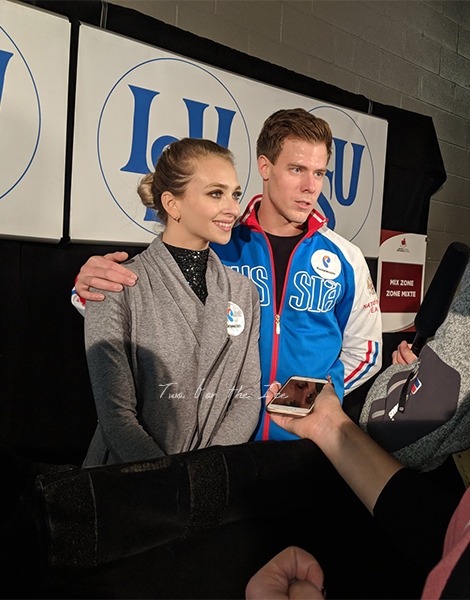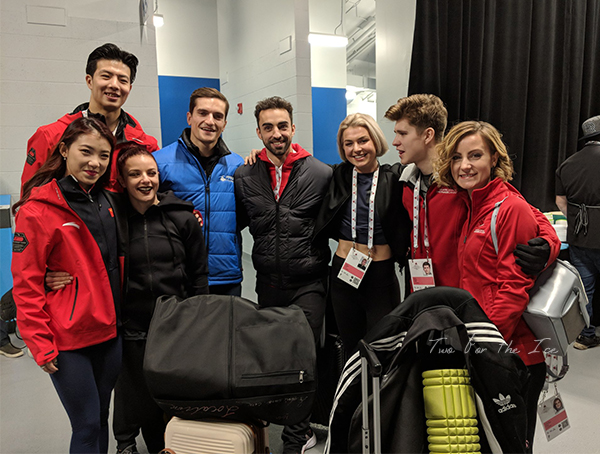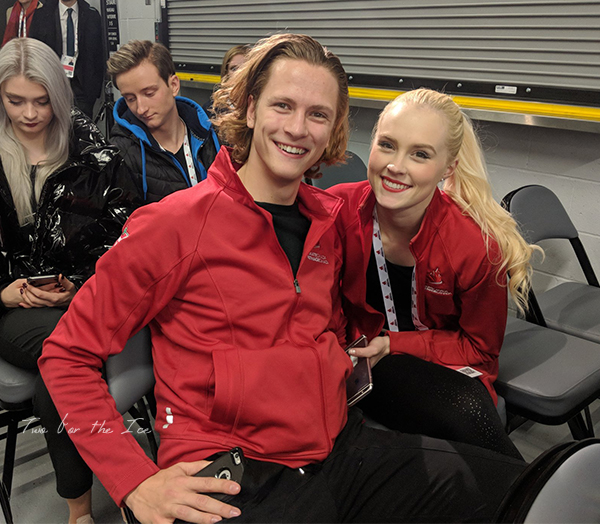by Claire Cloutier, special for Two for the Ice
The rhythm dance at Skate Canada featured some great performances from a strong group of ice dancers in Laval, Quebec. There were a few surprises as well, both in the standings and protocols.
Madison Hubbell & Zachary Donohue of the U.S., skating in their second event in as many weeks, performed a passionate, compelling tango to earn a new season’s best score of 80.49. What really stood out most about their dance was how emotionally engaged the team was; how expressive they were both facially and through gestures. It was simply a great program to watch.
Later, Hubbell said that was exactly what they were going for. “We wanted to improve on our performance,” she explained.
Coming to this event directly from Skate America, Hubbell & Donohue only had one day’s training time before Skate Canada and knew they wouldn’t be able to really address any technical issues that arose at their first event.
“We wanted to let that go. It can be a little bit challenging doing two back-to-back events, because inevitably you get the protocol [from the first event], and you want to fix the things you didn’t get. But we also didn’t want to be in our heads, trying to get the technical. I think we were able to stay really connected between the two of us. And obviously, the ending went better here,” Hubbell said with a laugh, referring to Donohue’s unexpected fall at the end of their rhythm dance at Skate America.
“I think it’s a very strong performance. We’re happy with it for October,” Hubbell declared. “And we can’t wait to have this next month to keep improving.”
The team expects to take a few days off after Skate Canada. “We’ll be mostly hibernating, I think. Catching up on a lot of sleep and rest,” Hubbell said.
But they’ll only take a few days away. “The environment in [training center] Gadbois is so special—the intensity, with everybody going to competitions—that we don’t want to miss out on that,” Hubbell noted. “That energy will really help us keep the momentum.”
Donohue agreed, saying: “The training atmosphere is incredible. We’ve just done the first two [Grand Prixes], so we now have four more weeks of people competing. That energy, that power in the rink—we enjoy sharing it with each other, because we know we can learn from it. It’s a pretty nice environment.”
Russian team Victoria Sinitsina & Nikita Katsalapov took second place in the RD, in a bit of a surprise. After a difficult Olympic season that saw them withdraw from Russian Nationals, Sinitsina & Katsalapov are on the comeback trail, starting with a win at Ondrej Nepela Trophy last month and continuing with their strong rhythm dance here.

Sinitsina and Katsalapov in the mixed zone after the 2018 Skate Canada International rhythm dance. Photo by Claire Cloutier.
After their poor showing at Russian Nationals last year, things were “pretty tough,” admitted Katsalapov. “The only right decision was to forget what happened and to start again from the beginning. Not to give up. That feeling is the worst feeling; I had to throw it away.”
The couple said everything is going much better now, and they’re particularly enjoying their rhythm dance. “We love tango,” enthused Katsalapov. “We’re working with a beautiful, amazing couple” to develop the dance, he explained. “They are world champions this year in Argentine tango. These guys taught us a lot on the floor. If I wasn’t in skates now, I would like to show you some tango. But we try to do it on the ice.”
Although the couple had a few small errors and missed levels on the twizzles and their rotational lift, their classic interpretation of tango is finding favor with both judges and audiences. “Today, our dancing was smooth. There were a few minor mistakes. But we improved our tango, compared to our first competition in Bratislava. So we are not overly pleased, but we are not upset. It was a good working performance, and we are looking forward to the free dance,” said Katsalapov.
Olivia Smart & Adriá Díaz of Spain took third place with a commanding performance of their rhythm dance. They earned a big ovation from the crowd, and the judges seemed to approve as well. Some of their PCS marks ranged into the 9s.
“Adriá and I are very pleased with how we went out and performed in our rhythm dance,” Smart said afterward. “We were very centered in ourselves, and we went out and did what we do in training every day. The crowd was way louder than at our last two competitions. So we’re pleased with our results. We know we have a lot to work on, technical-wise. But we know it’s step by step, a work in progress throughout the season.”
France’s Marie-Jade Lauriault & Romain Le Gac took fourth with a sparkling, entertaining rhythm dance set to music from Chicago. Afterward, the couple was very pleased and excited with their performance.

Gadbois Centre training mates at 2018 Skate Canada International. Photo by Claire Cloutier.
“We have fun with it, and I hope people can feel it,” Lauriault agreed.
The couple discussed the choice of their rhythm dance. “We were quite sure we wanted to do Chicago,” Lauriault explained. “But the question was, is everyone going to skate to ‘Cell Block Tango’? Because you don’t want to be all skating the same music.”
But they knew that no one else in their Gadbois training group was going to use the music. “And because we are 16 couples in Montreal, [and we’re the only one doing Chicago], we say probably not so many couples are going to skate to it. Actually, there are two others [outside of Gadbois]. But it’s okay.”
The program features a particularly stunning costume for Lauriault. She said that she worked with a new costume designer, Sylvie Duval, to create this dress. (Le Gac’s costume was done by their previous designer.)
“I tried something new, and I’m really happy,” Lauriault said of her work with Duval. “The process was really fun. She was so open, she had a lot of ideas. I don’t have an easy shape to dress, because I’m quite small, and you want to look tall on the ice. And I’m muscular, too. But she understood what I wanted—to have a more woman’s style, mature, not a little girl any more.”
Unfortunately, it was a rather disappointing day for the top Canadian ice dancers in the rhythm dance. Piper Gilles & Paul Poirier unexpectedly tripped during their rhythm dance and could only place fifth, although their PCS was good—third in the segment. Meanwhile, Canadian teammates Carolane Soucisse & Shane Firus fell during their dance and placed ninth.
The third Canadian dance duo, Haley Sales & Nikolas Wamsteeker, placed tenth. However, with no expectations coming in, they were satisfied with their performance.

Sales and Wamsteeker at the 2018 Skate Canada International free dance draw. Photo by Claire Cloutier.
“It exceeded all our expectations. It was a great event,” agreed Wamsteeker.
The team said they had been working on the flow and connection of their rhythm dance prior to the event. “Drilling those key points in the [Tango] Romantica,” explained Wamsteeker. “Still needs lots of work, but it’s getting there.”
Prior to this season, neither Sales nor Wamsteeker had ever skated the Tango Romantica. In fact, they had never skated any type of tango together. However, the team is enjoying this year’s compulsory rhythm.
“It’s a very difficult dance, but very beautiful,” Sales said. “The dance is 55 seconds, so it’s almost a minute of the [rhythm] dance. The rhumba last year was only 16 seconds, so it was a big step for us.”
“I love that fact, though,” Wamsteeker put in. He said of the tango, “It’s got some fancy moves. I love it. I think it’s more entertaining for the audience, too, compared to other compulsory dances. I hope we get to do it again in the future.”
The team worked with tango dancers from Argentina to learn the compulsory. “They were very helpful with getting into the character,” Wamsteeker said. They also worked with another expert to develop their expression of the dance.
The difficulty of the Tango Romantica section was illustrated by the technical callers’ tough scores for this segment of the rhythm dance. Many teams earned only level 1s or basic level on their compulsory sections, with even Hubbell & Donohue getting a level 1.
Asked later what the problem was on that compulsory section, Madison Hubbell said frankly, “I don’t know. Luckily, we have that guy back there—Patrice [coach Patrice Lauzon]. And he’s probably going to think about it for a while. And when I go back to training, he’ll tell me what to do. Luckily, I don’t have to carry that with me tomorrow, or tonight. He’s going to let me know next week what I need to work on.”
Adriá Díaz also had no answer to the questions about the compulsory. “The Tango Romantica is a pretty hard dance,” he said with a shrug. “It’s still the beginning of the season. We need to keep working on those key points, and the technique. Just working, working, trying.”
The other dancers laughed at Díaz’s comment—because for ice dancers, the work of perfecting their programs never ends.
